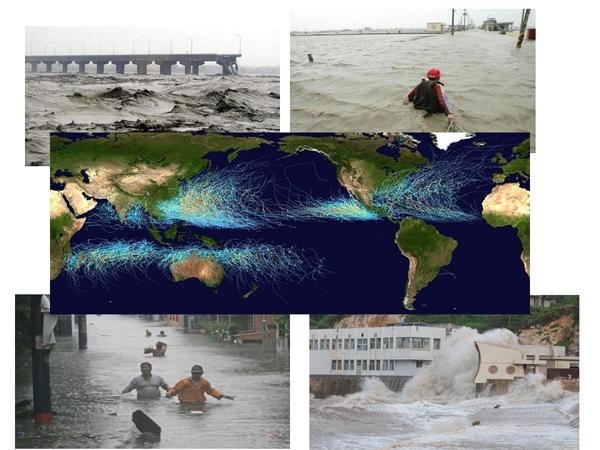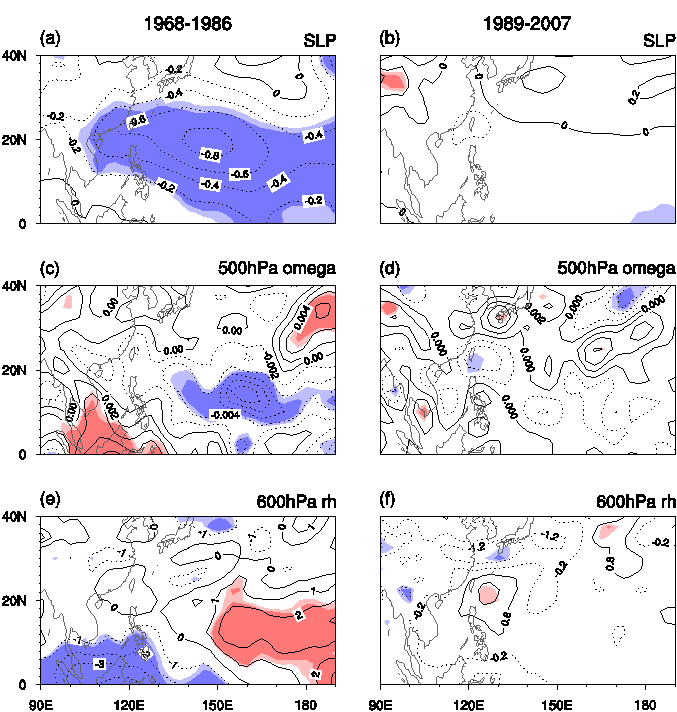Unstable Relationship between Spring AO and Following Summer Western North Pacific TC Activity
Date:2015-06-10
The tropical cyclone (TC) is one of the most severe natural disasters in the world. TCs can exert substantial influences on the economy, industry, agriculture, and people’s daily lives. Every year about seven or eight TCs make landfall in China, even twelve in a particular year. Thus, a better understanding of TC variability and its factors, and improved predictability of TC activity, are of great importance to society.

The western North Pacific (WNP) is the most active basin of tropical cyclogenesis, where one-third of global TCs form (Neumann, 1993). Typhoon Morakot in 2009 brought catastrophic damage in Southeast Asia, in particular, in Taiwan and Zhejiang provinces of China and Philippines. (Photos from Xinhua News).
Previous studies have showed that the frequency of summer TCs over East Asia has a positive correlation with the preceding spring Arctic Oscillation (AO) via modulation of atmospheric circulation. The researchers from the Institute of Atmospheric Physics examined the relationship between the spring AO and the following summer TC formation frequency over the eastern part of the western North Pacific (WNP), and found it experienced a pronounced interdecadal shift around the late-1980s (Fig. 1). The relationship is strong and statistically significant during 1968–1986, but becomes weak during 1989–2007.

Fig. 1. (a) Normalized time series of interannual components of spring (MAM-averaged) AO index and the following summer (JJA-averaged) TC formation index in the eastern part of the WNP. (b) Sliding correlations between the interannual components of spring AO index and the following summer TC formation index displayed at the center year of a 21-year window. The horizontal black dashed line in (b) indicates the correlation coefficient is significantly different from zero at the 10% level.
Their research results indicate that the spring AO leads to an El Ni?o-like SST anomaly, lower-level anomalous cyclonic circulation, upper-level anomalous anticyclonic circulation, enhanced ascending motion, and a positive midlevel relative humidity anomaly in the tropical western–central Pacific during 1968–1986, whereas the AO-related anomalies in the above quantities are weak during 1989–2007 (Fig. 2). Hence, the large-scale dynamic and thermodynamic anomalies are more favorable for TC formation over the eastern WNP during 1968–1986 than during 1989–2007.

Fig. 2. Anomalies of the following summer (a, b) SLP, (c, d) vertical velocity at 500 hPa, and (e, f) relative humidity at 600 hPa obtained as regressions upon the normalized spring AO index in (a, c, e) 1968–1986 and (b, d, f) 1989–2007. Contour intervals are 0.2 hPa in (a, b), 0.002 Pa s?1 in (c, d), and 1 % in (e, f).
Their analysis further shows that interdecadal change of spring AO-related cyclonic circulation anomalies over the WNP between the two epochs are related to the changes in the spatial pattern of the spring AO over the North Pacific.
The paper has been accepted to publish in Advances in Atmospheric Sciences.
Citation: Cao, X., S. F. Chen, G. H. Chen, W. Chen, and R. G. Wu, 2015: On the weakened relationship between spring Arctic Oscillation and following summer tropical cyclone frequency over the western North Pacific: A comparison between 1968–1986 and 1989–2007. Adv. Atmos. Sci., doi: 10.1007/s00376-015-4256.
Download: http://159.226.119.58/aas/EN/abstract/abstract2741.shtml.
Contact: Dr. CHEN Shangfeng, chenshangfeng@mail.iap.ac.cn
